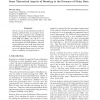108
click to vote
ICANN
2005
Springer
15 years 5 months ago
2005
Springer
A common assumption in supervised learning is that the training and test input points follow the same probability distribution. However, this assumption is not fulfilled, e.g., in...
COLT
2005
Springer
15 years 6 months ago
2005
Springer
We start by showing that in an active learning setting, the Perceptron algorithm needs Ω( 1 ε2 ) labels to learn linear separators within generalization error ε. We then prese...
75
Voted
IJCNN
2006
IEEE
15 years 6 months ago
2006
IEEE
— We analyze the generalization performance of a student in a model composed of linear perceptrons: a true teacher, ensemble teachers, and the student. Calculating the generaliza...
IJCNN
2006
IEEE
15 years 6 months ago
2006
IEEE
— In this paper a Particle Swarm Optimization (PSO)-based training strategy is introduced for fuzzy ARTMAP that minimizes generalization error while optimizing parameter values. ...
IDEAL
2007
Springer
15 years 6 months ago
2007
Springer
The dependence of the classification error on the size of a bagging ensemble can be modeled within the framework of Monte Carlo theory for ensemble learning. These error curves ar...
124
click to vote
COLT
2007
Springer
15 years 6 months ago
2007
Springer
We describe and analyze a new approach for feature ranking in the presence of categorical features with a large number of possible values. It is shown that popular ranking criteria...
104
click to vote
IJCNN
2007
IEEE
15 years 6 months ago
2007
IEEE
— To obtain accurate modeling results, it is of primal importance to find optimal values for the hyperparameters in the Support Vector Regression (SVR) model. In general, we sea...
87
Voted
ICML
2001
IEEE
16 years 1 months ago
2001
IEEE
This is a survey of some theoretical results on boosting obtained from an analogous treatment of some regression and classi cation boosting algorithms. Some related papers include...
103
Voted
ICML
2003
IEEE
16 years 1 months ago
2003
IEEE
We examine the set covering machine when it uses data-dependent half-spaces for its set of features and bound its generalization error in terms of the number of training errors an...
ICPR
2000
IEEE
16 years 1 months ago
2000
IEEE
An important theoretical tool in machine learning is the bias/variance decomposition of the generalization error. It was introduced for the mean square error in [3]. The bias/vari...





